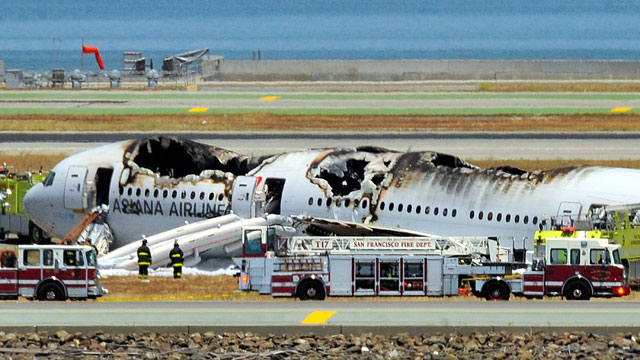The airport's statement doesn't mention the most publicized emergency response failure the day of the accident: the death of a passenger who survived the crash but was struck and killed by a San Francisco fire truck. The injured teenage girl had been placed alongside the plane, then covered in foam as firefighters tried to contain a blaze on board the Asiana 777 jetliner. A firefighter responding to the crash accidentally ran over the victim.
The text of the airport release is below:
SAN FRANCISCO - November 20, 2013 - San Francisco International Airport (SFO) today issued preliminary recommendations from a self-evaluation of the response and recovery following the crash of Asiana Flight 214 incident on July 6, 2013. Three weeks after the accident, SFO initiated a self-review process, separate and unrelated to the NTSB investigation, to identify best practices and make recommendations for future response efforts. The debriefing process, facilitated at SFO’s request by the independent consulting firm of ICF SH&E, involved more than 120 individuals from 20 local, state, federal, and airline agencies. The full report of ICF’s analysis has yet to be completed, but SFO shared preliminary findings, as it continues to improve its emergency response preparedness.
“While our thoughts continue to be with the victims and their families, I am proud of the emergency response to the Asiana crash that saved many lives,” said Airport Director John L. Martin. "Reflecting the Airport culture of continuous improvement, we engaged the entire SFO community, and mutual aid agencies to examine our response and recovery to ensure we are even better prepared for the future. Safety and security remain our top priority.”
Preliminary recommendations from the report note the successful coordination of multiple parties involved in response and recovery. These included SFO staff, first responders, area hospitals, relief organizations, federal agencies and airlines. The Airport began re-opening runways within hours of the accident, and coordinated a multi-agency effort to remove the aircraft wreckage, clean, pave, paint, and re-certify the damaged runway for use within 42 hours of the NTSB’s conclusion of on-site investigations.
Areas for improvement included the adoption of common Emergency Medical Response Procedures (EMS) between San Francisco and San Mateo counties, an effort already under way, and the integration of additional medevac resources. Customer service initiatives, such as keeping airport restaurants open 24 hours and assisting customers with hotel rates, were also cited as items for inclusion in ongoing emergency procedures.
SFO shared the recommendations and the Airport’s experience at Airports Council International (ACI) Operational Briefing at SFO. More than 144 airport staff from 44 airports around the country attended. “We felt it was our responsibility to share what we had learned with other airports,” Director Martin said.
Three weeks after the accident, SFO commissioned a self-review process, consisting of 3½ days of de-briefing facilitated by the consulting firm ICF. In addition to Airport personnel, other agencies attending the de-briefings included the Red Cross, Customs and Border Protection (CBP), and local police and fire departments. A standard evaluating program was used to evaluate effectiveness, the Homeland Security Exercise and Evaluation Program (HSEEP). Some of the highlights are:
Areas of Strength
- Strong sense of commitment exhibited among first responders; Airfield Safety Officers were first on the scene, along with fire and police staff
- Strong sense of shared goals evident among all parties
- Public Information was disseminated in a timely manner via multiple channels, with joint participation by the San Francisco Mayor, SFFD, SFPD, as well as federal agencies, including the FBI and NTSB
- Full airport operations were returned quickly and efficiently: Runways 1L/1R reopened within hours; Runway 28R opened Sunday, July 7th. Runway 28L opened, Friday, July 12th
Best Practices, Areas for Improvement:
While many of the recommendations listed below emerged organically during the response and recovery, SFO will formally include many of them in its operations manuals:
Medical resources – Improve Integration of Medical Resources
- Evaluate role of SFO’s full-service Medical Clinic as a future resource
- Coordinate medevac helicopter operations – incident commander to assign for coordination where required
- Adopt standardized triage procedures – EMT3 methodology to be used as common EMS protocol between San Francisco and San Mateo counties
Customer Service – incorporate response actions into procedures for emergency response
- Keep SFO restaurants open 24 hours to assist passengers stranded in terminals
- Work with the San Francisco Travel Association (SFTA) to establish distressed passenger hotel rates to reduce risk of price-gauging
- Use social media to communicate airline flight change and cancellation policies to travelers

